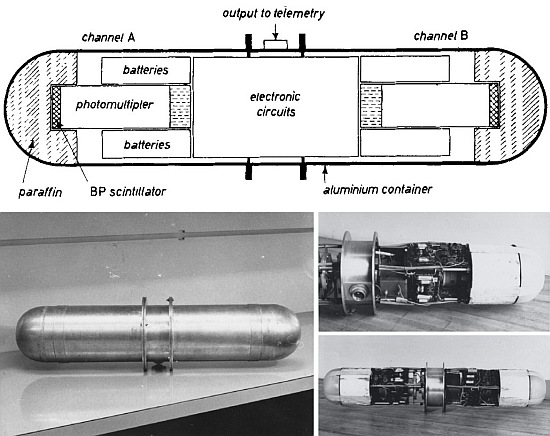Purpose of the flight and payload description
The objective of the flight was to measure the flux of low neutrons employing a detector based on boron-plastic scintillator counters. The instrument was designed and manufactured by the Istituto Nazionale di Fisica Nucleare, Universitá di Milano, Italy
At left we can see an image and scheme of the fast neutron detector. It consisted of two boron-plastic scintillator discs, A and B, each fitted in a paraffin block (to slow down the neutrons) and viewed by photomultipliers. Disc A contains boron enriched to 92 % in 10B isotopes while B is of natural boron (19 % 10B). The electronic circuits were lodged between the bases of the two photomultipliers. Twenty-four Ni-Cd cells with a 0.9 ampere-hours capacity were situated around the photomultipliers. These were capable to provide sufficient power for 14 hours of operation.
The whole instrument was encased in a pressure-tight aluminium container. The instrument weighed 5.4 kg of which 2.2 kg was the weight of paraffin and batteries alone.
The Boron plastic scintillators consisted of a plastic containing ZnS and boron plastic, in a ratio 2:1 by weight, pressed on to a 5 cm diameter plexiglass disc, in which were cut concentric grooves 0.9 mm deep, the whole backed by an aluminium disc of 0.5 mm thickness. The photomultipliers used were RCA 6655A, tile voltages applied being adjusted to obtain equal gain on both channels by means of a calibration with NaI crystal - Cs source assembly.
The electronic circuits consisted of two counting channels plus auxiliary circuits. The counting rate was transmited to the ground by a telemetry system using two Irig channels, each count being signaled by a switch between two values of the frequency within each channel. The 60 mW transmitter was quartz controlled at 144 Mhz and amplitude-modulated. Data on the atmospheric pressure and the internal temperature of the instrument during flight were transmitted by a standard radiosonde provided by the meteorological service of the Italian Air Force.
Details of the balloon flight
Balloon launched on: 9/16/1962
Launch site: Linate Airport, Milan, Italy
Balloon launched by: Istituto Nazionale di Fisica Nucleare (INFN), Milano
Balloon manufacturer/size/composition: Weather Balloon
End of flight (L for landing time, W for last contact, otherwise termination time): 9/16/1962
Landing site: In northern Italy
External references
- Measurement of the cosmic-ray neutron flux in the atmosphere Il Nuovo Cimento, 29(1), 103-117
15923If you consider this website interesting or useful, you can help me to keep it up and running with a small donation to cover the operational costs. Just the equivalent of the price of a cup of coffee helps a lot.


